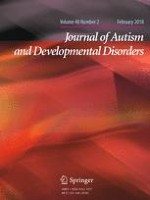26-10-2017 | Original Paper
How Adolescents with Autism Spectrum Disorder (ASD) Spontaneously Attend to Real-World Scenes: Use of a Change Blindness Paradigm
Gepubliceerd in: Journal of Autism and Developmental Disorders | Uitgave 2/2018
Log in om toegang te krijgenAbstract
Visual attention of adolescents with autism spectrum disorder (ASD) was assessed using a change blindness paradigm. Twenty-five adolescents with ASD aged 12–18 years and 25 matched typically developing (TD) adolescents viewed 36 pairs of digitized real-world images. Each pair of images was displayed in a ‘flicker paradigm’ whereby a particular item alternately appeared and disappeared. This item was either a central or a marginal detail of the scene. Change detection response times were measured and compared between groups. Marginal details were more difficult to detect than central details of the scenes in both groups, however, the response times of the ASD group were lower than the TD group. These results challenge the hypothesis of superior visual detection in ASD.
